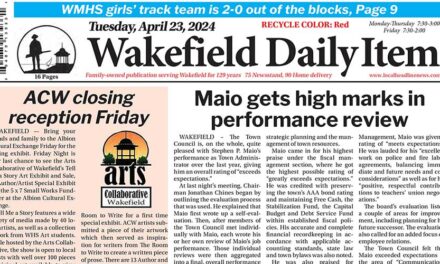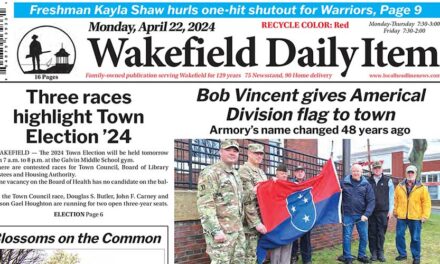Published in the April 27, 2017 edition.
By MARK SARDELLA
Most people think Wakefield is a pretty nice town. We have two lakes, a beautiful Common and a walkable downtown area with some great restaurants. We have easy access to public transportation and are near two major highways. Oh, and we are one of the few places outside of big cities that still has a daily, family-owned newspaper.
And, of course, there’s Fred’s Franks.
What’s not to like?
But there is a small but vocal cohort that takes a strange delight in hating the town, whether they were born here and elected to stay or came here to live by choice. For them, Wakefield never seems to measure up to their expectations and the grass always looks greener in neighboring communities like Lynnfield, Reading and Melrose.
This municipal self-loathing is nothing new. Growing up here way back in the 20th century, I can remember people thinking they were very clever and edgy when they referred to the town as “Wastefield,” and dubbed our Lake “Quannapolluted.”
It used to be that the audience for these rantings was limited to the bar stools at the Three Cs or the West Side Social Club on a Friday night.
But the age of social media has provided the current generation of curmudgeons with a comparatively limitless audience and a safe space from which to spew their cynical rants against the town.
We’re not talking about constructive criticism here. I guarantee that these keyboard pundits seldom read a local newspaper, never attend Town Meeting and are among the 82 percent of adults who didn’t bother to vote in Tuesday’s Town Election. Based on some of their comments, I sometimes wonder if they ever leave their basements.
But they can tell you exactly what’s wrong with the town and they’re convinced that they are the only ones who have figured it out.
They crawled out of the woodwork recently when someone posted on a Wakefield community Facebook page an online list of the “Top 100 Places to Live” in Massachusetts. The list, he couldn’t resist pointing out, did not include Wakefield.
It was one of those lists you see from time to time on the internet created by a “team” of “researchers” in some out-of-state office park who couldn’t find Wakefield if you spotted them an atlas and a Garmin.
But they know how to crunch “data” in order to determine which are the most desirable communities in a state most of them have probably never set foot in. This particular list was created by a group of “analysts” working in Pittsburgh.
But this meaningless list was enough to spark a lively round of Wakefield-bashing in the Facebook group.
One commenter cited “high taxes and poor roads” as reasons Wakefield didn’t make the list. Never mind that most of the towns on the list (like Dover, Wellesley, Lincoln and Duxbury) have far higher taxes than Wakefield. And I’d wager that the commenter has no idea that the town adds several hundred thousand dollars to supplement the annual Chapter 90 funds it gets from the state for road maintenance. We could spend a lot more on road maintenance, but then that would mean higher taxes.
A bunch of people cited empty storefronts and the condition of the downtown. Never mind that Wakefield’s downtown has a lower commercial vacancy rate than the national average, according to a 2015 market study commissioned by the town. And now that we’re down to, I think, two empty storefronts, the vacancy rate is even lower.
You could wave a magic wand and upgrade all the storefronts in the downtown and people would still complain about the downtown looking shabby because it’s become a perception that’s rooted as much in groupthink as it is in reality.
Another person commented that Wakefield is like a big high school clique that’s hard to break into. I guess that’s why five of the seven members of Wakefield’s elected Board of Selectmen weren’t born or raised here.
One of the candidates in the recent Town Election claimed that one of the problems with Wakefield was policies that don’t encourage growth.
Meanwhile other people were noticing all of the development going on all over town, including Brightview, the new Hallmark Health building in Greenwood, the two big projects on North Avenue, another one about to start on Lowell Street and two more large projects in the Junction area currently going through permitting.
“Welcome to the city of Wakefield,” was the reaction of one Facebooker worried about overdevelopment. Talk about a no-win for the town. Apparently its anti-growth policies are turning Wakefield into Malden.
I don’t care if Wakefield is on some phony baloney top-100 list. But those determined to find every reason that Wakefield didn’t make the list might begin by looking in the mirror.





